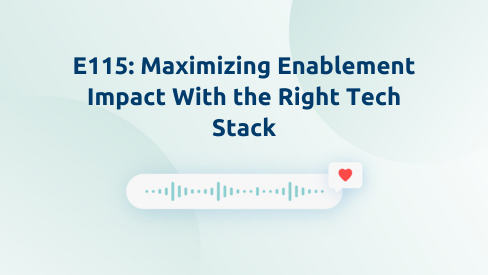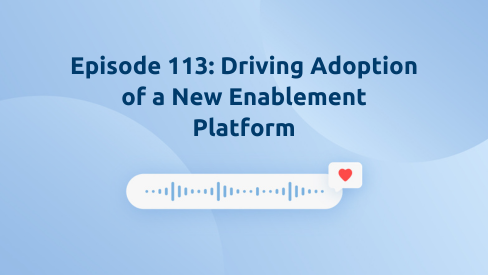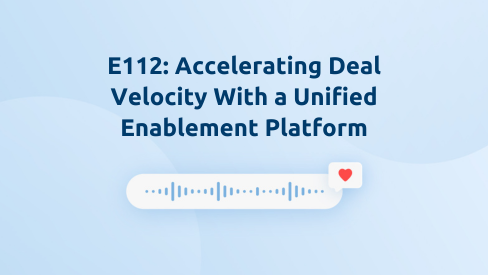Shawnna Sumaoang: Hi and welcome to the Win Win Podcast. I’m your host Shawnna Sumaoang. Join us as we dive into changing trends in the workplace and how to navigate them successfully.
Sales enablement teams are maturing and becoming more established each year, especially as more organizations are realizing enablement’s strategic impact on business. Research from Sales Enablement PRO found that organizations are 48% more likely to have high buyer engagement if their sales enablement processes have been in place for more than two years.
So how can you mature your practices as enablement becomes more established in your organization? Here to discuss this with us is Nav Nicholson, the principal sales enablement program manager at Redis. Thanks for joining Nav! I’d love for you to tell us about yourself, your background, and your role.
Nav Nicholson: Thanks for having me, Shawnna. As you introduced me already, I am the principal sales enablement program manager here at Redis. I own all of the sales tech stacks that we use internally, which include Highspot Outreach, Zoom Info, Linkedin Sales Navigator, and more. Not only do I own it, but I also run the workflows associated with those platforms, I own the ROI that we get from it. In addition to that, I’m also responsible to ensure that folks are using them in a consistent manner and the prescribed workflows.
As far as my background goes, I come from a success world. Before I jumped into enablement I was a customer success manager and my now boss actually stole me from the last place that I was at. He decided to poach me and he brought me on as an enablement person I think it’s actually a pretty good transition, especially for somebody that was in success to join an enablement team and run with the specific focus that I have. As a success person, you’re constantly trying to train and tell people what are prescribed flow, how you should do certain things and so I’m doing exactly that but more from an enablement perspective.
SS: Fantastic. Well, we’re excited to have you join us today. I’d love to start off by just understanding what enablement maturity means for enablement success within your organization.
NN: I feel like this is one of those things that every team is going to define totally different and it depends on who you’re talking to and what their typical focus looks like. My response might be a little different than what other people might say, but how we look at enablement maturity, we have some key components. The key components that we personally look at Redis are basically sales effectiveness, performance, and readiness. In addition to that, we also look at some buyer engagement, and another one that I’m responsible for is content management. All of those play a very critical part in our day-to-day that allows us to determine what our sales enablement maturity looks like.
SS: I think you’re spot on in your experience, how has your enablement strategy may be changed or evolved as it’s matured?
NN: When I joined our team there were only two people. We had a VP and a director, so I was one of the very first actual practitioner enablement higher that owned enablement from the day-to-day perspective, even though our director was super involved in the teams that we support. With me coming on board we started having more hands-on conversations with leadership and management. In addition to that, we started to have more one on one with reps too. Now we have nine people by the way. We started from two to nine and so it all happened because of the need and also the integrated approach that we’re starting to follow for our enablement team.
The way that we’re structured at the moment is we have a person that’s dedicated to account planning, we have head counts that are more focused on team-specific readiness, and then we have an onboarding person and a content writer and you already know that I own the tech stack and then we have a person that’s responsible for just sales performance. We also have charters that help us outline what our focus needs to look like for any given quarter or year. In addition to that, we do follow a lot of different workflows and frameworks that help us define our goals in the long run. I know that’s a long-winded response to your question but our maturity kind of depends on the need for the business, so where does the business want to be, and we kind of align our expectations to that.
SS: Awesome. That does tee us up nicely for the next question. What does your process look like for auditing and optimizing your current workflows?
NN: We’re very data-driven and when I say we’re very data-driven like we have multiple folks on our team that are actually really good at creating reports and putting together dashboards. I know most enablement teams typically work with their ops team, and so do we, we actually have a very strong relationship with our internal sales ops team, but our team also does a very fantastic job. I’m one of the people that create reports and dashboards for us that helps us understand the workflows that we’re creating landing. Like are folks actually following the suggested structure that we’ve given to them to achieve the goals that they have? We are very much so involved in their day-to-day function.
Say for prospecting, as an example, our team is actually telling them where to go, what to do, and at what time. Our flow starts with identifying your accounts and finding your prospects, adding them to the sequence, but what flow do you need to follow to get to that, we prescribe that to them. In addition to that, we also track who’s really performing well with the flow that we’ve suggested. It’s actually pretty easy to see if people are following the prescriptive workflows. The way we can track that is by using some of the reporting and metrics that we’ve rolled out to folks and ensuring that people are hitting those. If they’re not, it’s quite simple for us to know who are the folks that are actually not doing what we’re suggesting that they do.
The way we’re auditing that is using the reporting, but in addition to that our hands-on approach is more with the folks that are owning those teams. We work very closely with managers to kind of have a conversation where they let us know, okay, because these folks are not following the process that you’ve rolled out, here’s the potential reason that they might not be, or here’s the reason why we need to have a direct conversation with them to steer them in the right direction. We have one on ones with our reps that may not be following the workflow that we’re suggesting and we work very closely with the leaders and managers to ensure that we have buy-in from them. At the end of the day, enablement can do so much, but if we don’t have the necessary buy-in from the leadership, the stuff that we’re rolling out is not going to get picked up.
SS: Absolutely, you’re spot on. How do you go about tying your enablement processes and programs to specific business goals that as you said, your leaders care deeply about that will help you get that buy-in?
NN: That’s actually a great question. We have recently started focusing on this and because of how ingrained we are in our seller’s day-to-day, our team is tied to the revenue that our sales teams are generating. Not only do we come into play towards the end of the sale cycle, were involved from the start to the beginning, from prospecting to discovery to evaluation and purchase. All of that. We are very much so involved in the entire process. We’re fully integrated into their day-to-day.
The way that we determine how our processes are really helping the teams is based on the pipeline that they’re generating. In addition to that, we’re also tied to the revenue that they’re generating. If the teams are not producing enough pipeline, it comes down to us identifying, okay, is it because of the workflows that we’ve rolled out and those are not landing? Or is it because folks are actually not following those workflows which are leading to the gap in the pipeline that we were generating?
SS: I’m so excited to hear that you guys are starting to do that within your organization. I think that’s a huge step forward in helping enablement position itself strategically within the organization. What goals do you have for the next year in regard to maybe helping to evolve enablement maturity within your organization?
NN: I am a bit of a nerd when it comes to the maturity models and kind of identifying where we fall in that category. Obviously, I know there are so many different maturity models that are out there and so some of the ones that I’ve looked at recently are like the one from demand metrics and the one from Highspot and there are so many of them. I would say that as far as where we fall today we’re kind of like a good mix between data-driven and partially mature. No one’s ever going to tell you that their enablement team is like fully at a level where they’re optimized and their entire flows are fully integrated with everything. I think we do always have room for improvement.
As far as our organization goes or how our team is functioning as I said, we’re a key player in pipeline tracking and management. In addition to that, we are quite involved with ops and marketing. We also play a very critical factor in driving revenue and growth and we are supported by execs and leadership as I said. We also track usage and adoption, which I mentioned. Our team is extremely data-driven and we try to focus our initiatives based on what we’re really looking for as a team or as a company or as an organization. Our VP of enablement is very close to our CRO. Depending on what our chief revenue officer is looking for, our charters change and our initiatives also change. We always align our expectations with what the company needs and desires.
As far as our future, in the direction that we’re heading, I mean we all know that the economy is kind of experiencing ebbs and flows, so with that comes the revenue that your company is generating is also going to have ebbs and flows. On top of that, pipeline creation becomes quite important because nowadays folks are only going to have conversations with you if the product that you’re selling is necessary for their day-to-day and if it’s going to become a part of their mission-critical approach. Our focus for the rest of this year and going into next fiscal year is to ensure that our teams understand the requirements around, hey, you need to have conversations that are more pain based, you need to follow the workflows that we’re suggesting because those are actually going to help you win the deals that you might have staggered.
In addition to that, if you’re wanting to create a pipeline, it’s important that you follow the structure and the KPI metrics that we’ve rolled out because consistency is going to get you across the board. Being all over the place is not going to help you in any way. Again, long-winded response, but I think the direction that we’re going is going to be very much so just ensuring that we’re understanding their internal data, understanding how our teams perform and aligning our goals, and prioritizing our expectations with that.
SS: Now I’d love to get your perspective. What do you think other enablement practitioners should know about enablement maturity and what can you share to help them prepare their own journeys?
NN: I think the very first thing that they need to look at is how would you define your enablement maturity. How do you define your team’s primary focus? From there build that towards how you’re going to achieve that maturity and look at the primary criteria that are going to enable yourself and also the teams that you’re supporting and the part that leadership that’s supporting you is going to play in that. One of the things that I noticed last week when I was at Sales Enablement Society is folks are hungry to understand how other sales enablement teams are running the function. There’s a lot that goes into an enablement team and the way they function, but as far as the maturity goes for the enablement team, it’s very much so dependent on the desires and the requirements that your company has.
We’re lucky that our CRO understands the importance that an enablement team has in their day-to-day. Not every company does. For a lot of folks, you are going to have to do some internal selling in order for the teams to understand the critical part that the enablement team plays in the actual revenue-generating goals. Long story short, I think the things that enablement needs to consider as they’re going to mature is looking at what’s on the charter, obviously creating that charter on the front end, aligning that with the company goals and the desires that your leadership has, and ensure that you have buy-in from the team’s. Not only from the leadership and executive level but also from the front-line managers. Those front-line managers are the ones that are going to reinforce anything that you’re rolling out. Any framework that you’re rolling out or any workflows that you’re rolling out. If you don’t have to buy in from the front-line managers, whatever you’re sharing is not going to land and it’s not going to show any success.
In addition to that, once you do roll out those frameworks and once you do roll out workflows that you’re rolling out, make sure you have the plan to track the success. Make sure you’ve identified the metrics that are going to help you understand if the work you’re doing is making an impact. We’re at a place where nobody wants to just roll something out just because you think it’s the right thing, they want to see an actual impact that we’re making.
SS: Absolutely last question for you. To close, how has your organization leveraged Highspot to help achieve some of the business outcomes that you guys have seen through enablement?
NN: We rolled out Highspot almost 2.5 years ago at this point, and we actually replaced another competitor of yours. Folks didn’t really believe in a content management system prior to us rolling out Highspot, and here’s why. No one really owned that platform at the time and things were a complete mess. Once we rolled out Highspot, we started to organize our content in a way that it’s easier for people to find it. Now, I’m not going to say that we’re pro at it, one of the projects that I’m focusing on in the coming months is actually restructuring our Highspot content and how we’re presenting that to our sales team. To do that, I’ll be working very closely with our teams and kind of going through the format that we’ve put together and seeing if it will help them in identifying the content.
As far as using Highspot, it has played a very critical part in our seller’s day today. Not only are we using Highspot as a CMS, but we also use Highspot’s Training and Coaching capability and we use Highspot capabilities for our onboarding and so our boot camp sessions and our onboarding sessions, which is set up in a way where folks can just go into a Highspot and kind of complete this, so it’s self-paced. Not only are we just using this for onboarding purposes, but we also use that whenever we purchase a new product. We rolled out 6sense late last year, so I created an actual course. These were two separate courses, one for SDRs and one for AEs that outline the workflow that’s recommended as far as the usage of 6sense goes. That’s how we rolled that out. When we onboard 6sense folks actually had to go through that training, and so whenever a new hire starts, they all go through that training.
That’s just one example. We have many other examples where we’re using Highspot capabilities to ensure that folks understand from the front end instead of just going into some of those other platforms to kind of do whatever they want. Highspot has played a very critical role in our onboarding needs in addition to that also ensuring that our content is up to date. We track buyer engagement with our content, so how engaged are our buyers with some of the content that we’re creating? We have analytics and reporting on all of that too. I’m a big fan and love Highspot and excited to see the way we plan on evolving it in the coming months.
SS: I love to hear that. Thank you so much for joining us today. I really appreciate it.
NN: Absolutely. Thanks for having me.
SS: Thank you for listening to this episode of the Win Win podcast. Be sure to tune in next time for more insights on how you can maximize enablement success with Highspot.



